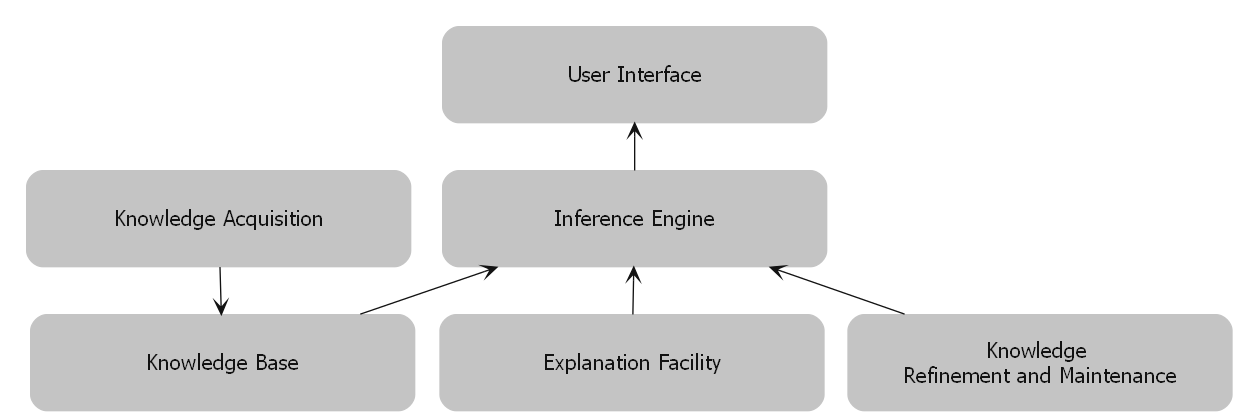Components of Expert Systems
In the rapidly evolving landscape of Artificial Intelligence (AI), one remarkable innovation that has gained considerable attention is the development of Expert Systems. These systems emulate the decision-making capabilities of human experts in specific domains, harnessing the power of AI to provide invaluable insights and solutions. At the core of Expert Systems lie their distinct components, which work synergistically to replicate human expertise. In this section, we delve into the intricacies of these components, exploring their roles and interactions within Expert Systems.
Knowledge Base
The cornerstone of an Expert System is its Knowledge Base (KB). This repository contains the domain- specific information, facts, rules, heuristics, and experiential data that an expert in the field would possess. This information is structured in a manner that the system can comprehend and utilize for decision-making. The Knowledge Base forms the foundation upon which the system's reasoning and problem-solving abilities are built.
Inference Engine
The Inference Engine is the intelligent core of the Expert System. It interprets the information stored in the Knowledge Base and applies logical reasoning to arrive at conclusions and solutions. It employs various inference mechanisms such as forward chaining (from facts to conclusions) and backward chaining (from goals to facts) to simulate the reasoning process of a human expert. The Inference Engine determines the sequence of steps needed to solve a problem and derives conclusions based on the available knowledge.
User Interface
To bridge the gap between the technical intricacies of the system and the user, a well-designed User Interface (UI) is crucial. The UI provides an intuitive platform for users to interact with the Expert System, input queries, receive recommendations, and understand the system's responses. A user-friendly UI enhances the accessibility and usability of the Expert System, ensuring that even those without technical expertise can benefit from its capabilities.
Knowledge Acquisition System
The process of infusing an Expert System with domain-specific expertise involves capturing the knowledge from human experts and transferring it to the Knowledge Base. The Knowledge Acquisition System facilitates this knowledge extraction process. It employs various methods like interviews, surveys, and observations to gather information from experts. The collected knowledge is then organized, refined, and integrated into the Knowledge Base of the Expert System.
Explanation Facility
One of the challenges of deploying AI systems is their perceived lack of transparency. Expert Systems address this by incorporating an Explanation Facility. This component elucidates the reasoning behind the system's decisions, allowing users to comprehend the basis for recommendations and solutions. Transparent explanations enhance the trustworthiness of the system and make it more acceptable to users.
Knowledge Refinement and Maintenance
The Expert System is not static; it evolves over time as new information emerges and the domain itself changes. The Knowledge Refinement and Maintenance component facilitates the continuous updating and improvement of the Knowledge Base. It ensures that the system remains relevant and up- to-date by incorporating the latest insights, rules, and data.

Depicting the fundamental constituents of an Expert System, @fig:components-of-expert-systems showcases the conventional elements in action. The central pillar is the Knowledge Base, housing specialized domain information, which is then interpreted by the Inference Engine to deduce outcomes. Enabling user engagement, the User Interface comes into play, while the Knowledge Acquisition System captures human wisdom for the Knowledge Base. Fostering transparency, the Explanation Facility expounds on system choices, and the Knowledge Refinement and Maintenance aspect ensures the system's continuous growth. The orchestration of these elements results in a holistic AI system proficient in mirroring expert decision-making within specific domains, effectively bridging the chasm between human expertise and machine intelligence.
Expert Systems have revolutionized decision-making across various domains, augmenting human expertise with AI capabilities. The harmonious interplay of components such as the Knowledge Base, Inference Engine, User Interface, Knowledge Acquisition System, Explanation Facility, and Knowledge Refinement and Maintenance drives the effectiveness and utility of these systems. As AI continues to advance, the synergy of these components will enable Expert Systems to provide even more sophisticated and insightful solutions to complex problems, reshaping industries and domains in the process.